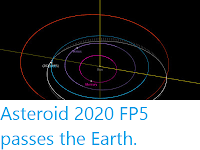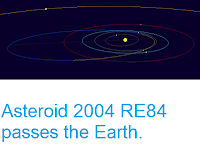Asteroid 2011 GM44 passed by the Earth at a distance of about 11 663 000
km (30.4 times the average distance between the Earth and the Moon, or 7.80% of the distance between the Earth and the Sun), at about 7.30 am
GMT on Monday 30 March 2020. There was no danger of
the asteroid hitting us, though were it to do so it would have
presented a considerable threat. 2011 GM44 has an estimated
equivalent
diameter of 220-680 m (i.e. it is estimated that a spherical object with
the same volume would be 220-680 m in diameter), and an object of this size would be predicted to be capable of passing
through the Earth's
atmosphere relatively intact, impacting the ground directly with an
explosion that would be 23 000-825 000 times as powerful as the
Hiroshima
bomb. Such an impact would result in an impact crater 3-10 km in
diameter
and devastation on a global scale, as well as climatic effects that
would last decades or even centuries.
Image of 2011 GM44 taken on 5 April 2011. The image is a composite of eleven 20 second esposures taken with the Tzec Maun Foundation's Takahashi TOA-150 f/7.3 refractor telescope at the Siding Spring Observatory. The dotted lines are stars, which have moved between exposures, with the single point at the centre of the image, indicated by the two lines, being the asteroid. Giovanni Sostero and Ernesto Guido/Comets & Asteroids - Small Bodies of the Solar System.
2011 GM44 was
discovered on 5 April 2011 at Siding
Spring Observatory in Australia. The
designation 2011 GM44 implies that it was the 1068th asteroid (asteroid M44 -
in numbering asteroids the letters A-Y, excluding I, are assigned
numbers from 1 to 24, with a number added to the end each time the
alphabet is ended, so that A = 1, A1 = 25, A2 = 49, etc., which means that M44 = 12 + (24 X 44) = 1068)
discovered in the first half of May 2011 (period 2011 G).
2011 GM44 has a 252 day orbital period, with an elliptical orbit tilted at
an angle of 49.3° to the plain of the Solar System which takes in to
0.38 AU from the Sun (38% of the distance at which the Earth orbits the
Sun, and roughly the distance at which Mercury orbits the Sun) and out to
1.19 AU (19%
further away from the Sun than the Earth). This means that close
encounters between the asteroid and Earth are fairly common, with the
last thought to have happened in March 2018 and the next predicted
in April 2022. Although it does cross the Earth's
orbit and is briefly
further from the Sun on each cycle, 2011 GM44 spends most of its time
closer to the Sun than we are, and is therefore classified as an Aten
Group Asteroid. As an asteroid probably larger than 150 m in diameter
that occasionally comes within 0.05 AU of the Earth, (2011 GM44
is also
classified as a Potentially Hazardous Asteroid. The asteroid also has
occasional close encounters with the planet Mercury, with the last
having happened in April 2008, and the next predicted for March 2024.
See also...
Follow Sciency Thoughts on Facebook.








